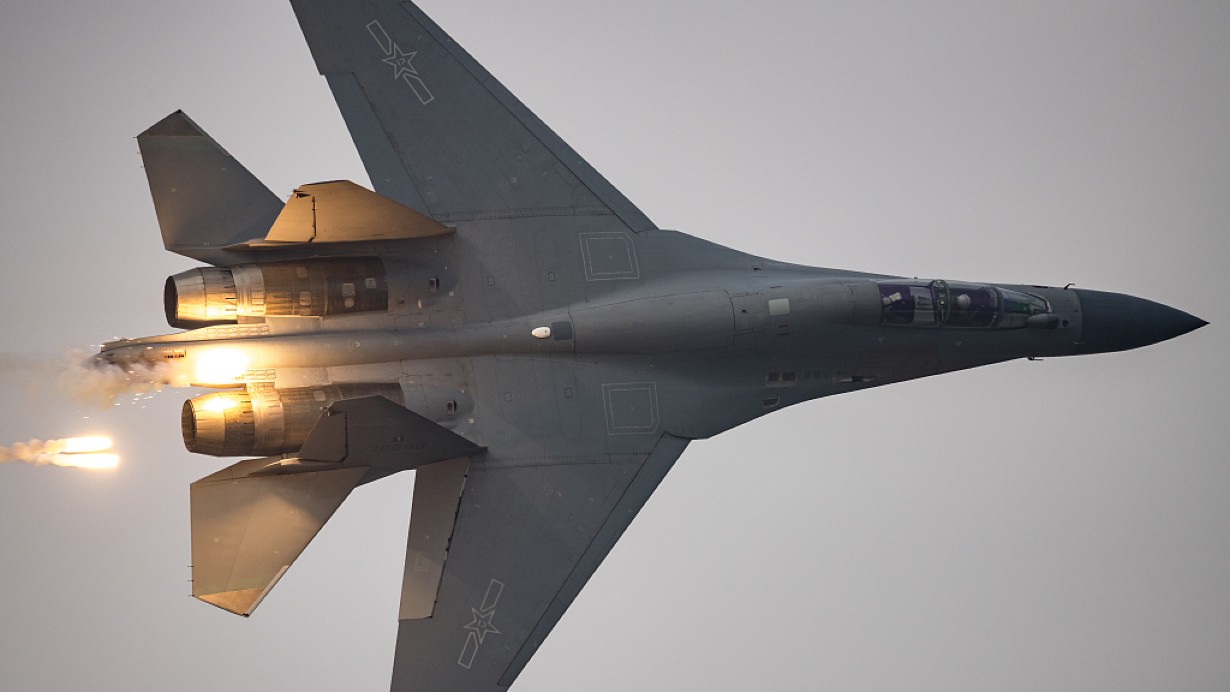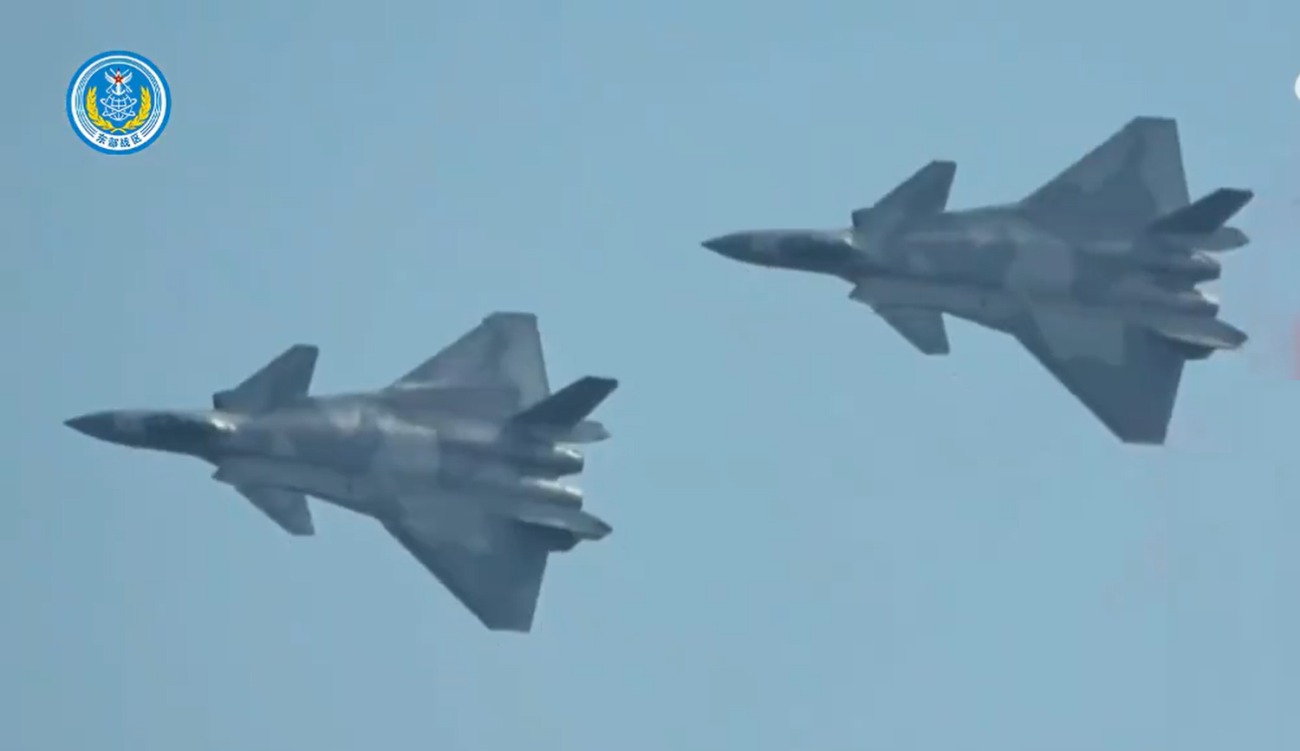Encounters between Chinese fighter jets and foreign aircraft over China’s approximately 9,000-mile-long coastline are a routine affair, and Chinese state-run media often report these incidents.
However, one such incident, reported last week by Chinese media, is not only making headlines but has also generated a heated debate among aerospace experts and followers.
On October 3, Global Times reported on a documentary shown on China Central Television (CCTV), where a PLA Air Force (PLAAF) pilot from the special mission aircraft formation claimed that he was able to simultaneously lock two foreign stealth fighter jets while flying the domestically developed J-16 fighter jet, forcing both jets to withdraw.
According to the CCTV report, the incident took place last year.
While the report has not disclosed which foreign stealth aircraft it was referring to, the only two aircraft that fit the description are the F-22 Raptor and the F-35 Lightning II. Both of these aircraft are frequently deployed in the Indo-Pacific region for training, war exercises, and regular deployments.
For instance, the F-22 Raptor has been deployed at various locations, including Kadena AB (Okinawa, Japan), Osan AB (South Korea), Andersen AFB (Guam), Kunsan AB (South Korea), and in the Philippines, at different times.
Similarly, the F-35 Lightning II has also been deployed in Japan, South Korea, Guam, and the Indo-Pacific theatre command.

Both the F-22 Raptor and the F-35 Lightning II are fifth-generation stealth aircraft, battle-tested and widely regarded as the world’s most advanced fighter jets, with a Radar Cross-Section (RCS) signature of less than 0.0015 m², making them almost invisible on radar.
On the other hand, the J-16 is only a 4.5-generation fighter jet.
This apparent capability difference is prompting analysts to question the official version of events and raise doubts about whether the CCTV report should be dismissed as state propaganda and psychological warfare.
The J-16 Interception Claim
State broadcaster CCTV last week aired an interview with Li Chao, a pilot from the People’s Liberation Army’s Western Theatre Command, who recounted the event that happened during a coastal training exercise last year, when he encountered two foreign fighter jets.
“They headed straight toward our two aircraft. Their intention was very clear—it was a provocation. With our backs to the territorial sea line, we had to intercept them,” recalled Li, who was operating China’s domestically produced J-16 fighter jet.
During the first encounter, Li locked onto the foreign fighter jet. Its wingman immediately broke away at high speed, while the other foreign fighter jet exited the combat zone and locked onto Li’s jet.
Seizing the opportunity, Li pulled up his aircraft and executed a barrel roll, flying inverted directly above the foreign jet, the Global Times reported.
“At that moment, my canopy was just 10 to 15 meters away from his. After completing this maneuver, I simultaneously locked onto both foreign fighter jets. In the end, both aircraft withdrew,” Li said.
The CCTV report said the confrontation was the only one of its kind to date.
“Since that encounter, this type of fighter jet has never appeared near China’s coastal waters,” it said.
This is by no means an isolated incident, as encounters between Chinese fighter jets and foreign aircraft are relatively frequent in the Indo-Pacific region.
The Frequent Interceptions In The Indo-Pacific
In June this year, the Chinese State-run media reported that the PLAAF’s J-20, J-15, and J-16 drove away foreign aircraft at different times.
China Central Television (CCTV) aired footage showing how the Chinese military dispatched two J-16 fighter jets to warn and expel a foreign aircraft that had breached China’s territorial sea boundary.
“China has a very long coastline, and the J-16 is a heavy fighter with ample fuel, capable of carrying missiles for sea and land attacks, as well as missiles for striking aerial targets. Facing aircraft like the P-8A anti-submarine patrol plane, we can dispatch J-16, J-15, or J-10 jets to warn and expel the aircraft,” Cao Weidong, a military affairs expert, was quoted as saying by CCTV.
Again in July this year, CCTV reported an encounter between the J-20 and an unnamed foreign stealth aircraft, most probably the F-35.
The EurAsian Times has reported on that encounter and its implications for the balance of power in the Indo-Pacific region.
Earlier, in March 2022, US Pacific Air Force Commander General Kenneth Wilsbach revealed that the J-20 of the PLA Air Force and the F-35 of the US Air Force had their first-ever ‘encounter.’

At the time, the US General said, “It’s a bit early to say what they intend to do with the J-20, so really all we’ve seen it do is air superiority. But we notice that they are flying it pretty well. We recently had – I wouldn’t call it an engagement – where we got relatively close to the J-20s along with our F-35s in the East China Sea, and we’re relatively impressed with the command and control associated with the J-20.”
Similarly, in March 2024, some reports in Chinese media stated that an unknown number of J-20s had just landed when they received news of foreign military aircraft approaching Chinese airspace. They immediately took off to intercept the threat.
However, what sets this latest incident apart is that, while in previous reports, China claimed to have intercepted foreign stealth aircraft with its own fifth-generation fighter jets, in the latest incident, Beijing claims that its 4.5-generation J-16 simultaneously locked onto two foreign stealth aircraft, forcing them to withdraw.
The J-16 Flanker-N
The Shenyang J-16 (NATO reporting name: Flanker-N) is a Chinese 4.5-generation multirole strike fighter developed by the Shenyang Aircraft Corporation. Derived from the J-11BS (a twin-seat variant of the Su-27), it emphasizes air-to-air and air-to-ground missions with advanced avionics.
However, the J-16 has advanced radar and fire control systems.
The J-16 is equipped with an indigenous Active Electronically Scanned Array (AESA) radar. It has a reported range of 200–250 km for fighter-sized targets (RCS 1 m²), and it can track up to 15–20 air targets simultaneously.
Furthermore, the J-16 is equipped with an Infrared Search and Track (IRST) system for passive detection capabilities of up to 50–80 km.
Wang Songxi, a flying instructor at the People’s Liberation Army Northern Theater Command Air Force, during an interview with CCTV, described the J-16 as “flawless.”
“In terms of performance, the J-16 is superior to all types of aircraft I have flown. Speaking of the control capacity of the aircraft… it has huge breakthroughs in radar and fire control systems in comparison with previous aircraft,” Wang Songxi said.
Wang described the J-16 as superior to the Russian Su-30 and even surpassing the Chinese J-10C, due to its twin-engine configuration and two-seat cockpit.
However, are these capabilities sufficient to lock onto stealth targets?
Can J-16 Lock F-22 or F-35?
The short answer is yes, under specific circumstances, the J-16 or any fourth-generation aircraft (e.g., F-15, F-16, Su-30, MiG-29) can detect and potentially lock onto a stealth aircraft, such as the F-22 Raptor or F-35 Lightning II.
Stealth aircraft have a low RCS, often compared to a small bird. However, at very close ranges, a 4th-generation aircraft’s radar may detect a stealth aircraft, as radar signal strength increases inversely with distance.
Furthermore, within visual range (WVR), a 4th-generation aircraft could utilize infrared search and track (IRST) systems or electro-optical sensors to detect heat signatures or visual cues, thereby bypassing radar stealth.
Also, at certain angles, even stealth aircraft can be tracked and locked.
Stealth aircraft are optimized for low observability from frontal aspects, but side or rear profiles have higher RCS. If a 4th-generation aircraft maneuvers to a non-frontal angle (e.g., side-on or rear), its radar may have a better chance of detecting the stealth aircraft.
In training exercises, a fourth-generation aircraft has locked onto a stealth aircraft multiple times. For instance, during the 2012 Red Flag-Alaska exercise, the Eurofighter Typhoon reportedly achieved multiple kills on the Raptors.
Similarly, during NATO’s Trident Atlantic 25 exercise in Finland, a French Rafale jet achieved a simulated “kill” against a U.S. F-35A, with footage showing the Rafale locking onto the F-35 and a simulated missile launch command.
Additionally, the J-16’s AESA radar and IRST features are significant capability boosters, as they can lock onto stealth aircraft at close ranges, utilizing either the advanced AESA radar or the IRST features.
The statement by the J-16 pilot mentions two crucial details: one, during the encounter, his “canopy was just 10 to 15 metres (33 to 49 feet) away from the foreign jet.” And, two, that he performed a barrel roll and flew inverted over one of the foreign jets.
This means that the encounter took place at close range, and the aircraft were not facing each other from frontal angles. Under both these circumstances, i.e., within visual range, a stealth aircraft can be locked by a fourth-generation aircraft.
So, the claim by the Chinese pilot can not be rejected outright. However, the possibility of a J-16 simultaneously locking two stealth jets could be part of Beijing’s PR campaign.
Furthermore, the pilot’s claim that since this encounter in 2024, the said foreign stealth aircraft have not returned to China’s maritime borders makes it sound even more fishy.
Sumit Ahlawat has over a decade of experience in news media. He has worked with Press Trust of India, Times Now, Zee News, Economic Times, and Microsoft News. He holds a Master’s Degree in International Media and Modern History from the University of Sheffield, UK.
- VIEWS PERSONAL OF THE AUTHOR.
- He can be reached at ahlawat.sumit85 (at) gmail.com




